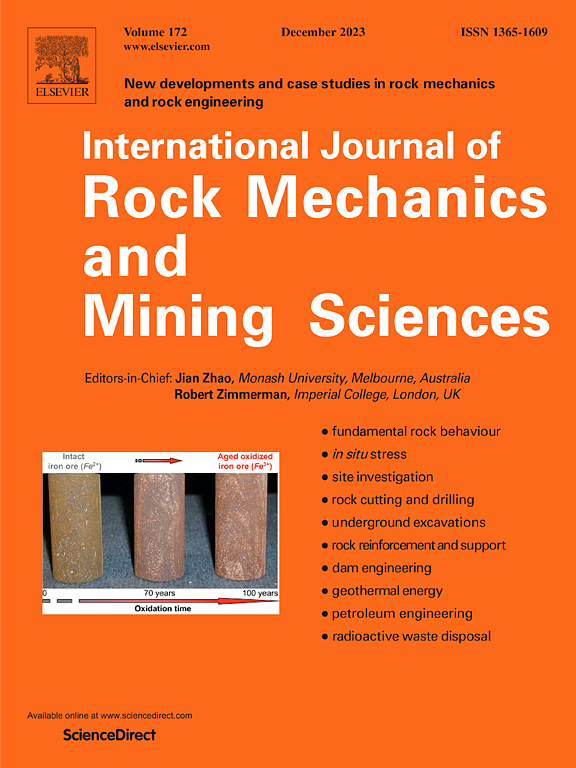Propagation and arrest of multiple radial thermal fractures transverse to a horizontal well
IF 7.5
1区 工程技术
Q1 ENGINEERING, GEOLOGICAL
International Journal of Rock Mechanics and Mining Sciences
Pub Date : 2025-03-24
DOI:10.1016/j.ijrmms.2025.106092
引用次数: 0
Abstract
Transverse thermal fractures in horizontal wells can be induced by cold fluid injection into high-temperature formations during drilling, geothermal production, CO2 storage, etc. As these fractures propagate, some are arrested due to stress interaction, resulting in a hierarchical fracture pattern. This study investigates the propagation and arrest of radial transverse thermal fractures in a horizontal well driven by 1-D radial heat conduction using an axisymmetric model. We derived a new elasticity equation for multiple radial thermal fractures in a horizontal well, and developed the dimensionless governing equations, in terms of dimensionless fracture penetration depth , spacing , aperture , time , and two model parameters (dimensionless net confining stress and wellbore radius ) through parameter scaling. Displacement discontinuity method was employed to discretize the governing equations and the dimensionless solutions [, , ] for the critical states at fracture arrests were solved through stability analysis. The fully transient solutions with stepwise fracture spacing were then obtained to predict the hierarchical fracture pattern. Our findings indicate that the solutions for the radial transverse fractures are asymptotic to those for half-plane thermal fractures at early time and the evolution of fracture penetration depth approaches to a scaling law at late time. Application to a real geothermal site showed that thermal fractures reach depths of 0.48, 3.48, and 28.29 m, spacings of 0.46, 2.34, and 13.20 m, and apertures (at the wellbore wall) of 0.37, 1.53, and 6.15 mm at 1, 100 and 10,000 days of cooling, respectively.
横向至水平井的多个径向热裂缝的扩展和停止
水平井横向热裂缝可由钻井过程中向高温地层注入冷流体、地热开采、CO2封存等因素引起。随着裂缝的扩展,一些裂缝由于应力相互作用而受阻,从而形成分层裂缝模式。本文采用轴对称模型研究了一维径向热传导驱动下水平井径向横向热裂缝的扩展和止裂。推导了水平井多径向热裂缝的弹性方程,并通过参数标度建立了基于无因次裂缝侵深L、裂缝间距D、孔径Ω、时间τ和两个模型参数(无因次净围应力T和井筒半径a)的无因次控制方程。采用位移不连续法对控制方程进行离散化,通过稳定性分析求得断裂停止临界状态的无因次解[L(τ,T,A), D(τ,T,A), Ω(τ,T,A)]。得到了裂缝间距逐级递增的全瞬态解,用于预测分层裂缝模式。研究结果表明,径向横向裂缝的早期解与半平面热裂缝解渐近,裂缝穿透深度的演化在后期趋近于一个标度律L=fT, τ1−T/2。在实际地热现场的应用表明,在冷却1100天、100天和10000天时,热裂缝深度分别为0.48、3.48和28.29 m,裂缝间距分别为0.46、2.34和13.20 m,井筒壁面孔径分别为0.37、1.53和6.15 mm。
本文章由计算机程序翻译,如有差异,请以英文原文为准。
求助全文
约1分钟内获得全文
求助全文
来源期刊
CiteScore
14.00
自引率
5.60%
发文量
196
审稿时长
18 weeks
期刊介绍:
The International Journal of Rock Mechanics and Mining Sciences focuses on original research, new developments, site measurements, and case studies within the fields of rock mechanics and rock engineering. Serving as an international platform, it showcases high-quality papers addressing rock mechanics and the application of its principles and techniques in mining and civil engineering projects situated on or within rock masses. These projects encompass a wide range, including slopes, open-pit mines, quarries, shafts, tunnels, caverns, underground mines, metro systems, dams, hydro-electric stations, geothermal energy, petroleum engineering, and radioactive waste disposal. The journal welcomes submissions on various topics, with particular interest in theoretical advancements, analytical and numerical methods, rock testing, site investigation, and case studies.

 求助内容:
求助内容: 应助结果提醒方式:
应助结果提醒方式:


